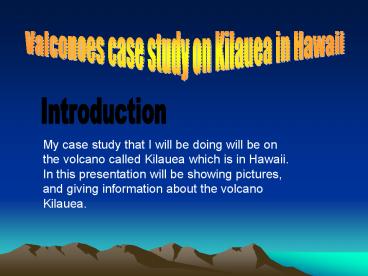Valconoes case study on Kilauea in Hawaii PowerPoint PPT Presentation
Title: Valconoes case study on Kilauea in Hawaii
1
Valconoes case study on Kilauea in Hawaii
Introduction
My case study that I will be doing will be on the
volcano called Kilauea which is in Hawaii. In
this presentation will be showing pictures, and
giving information about the volcano Kilauea.
2
From Magma to Lava
The rocks melt because of the extremely high
temperatures and pressure, which will become
liquid rock or magma. The large body of magma
that has been formed, it rises through the denser
rock layers towards Earths surface. Lava is
magma that has reaches the surface.
Lava Types
Magma comes in different compositions and
flavors. They will all produce a different
lava, more viscous andesite, fluid and fast
moving basalt to slower. Rocks melt in different
temperatures they are made up of collections of
minerals. The make-up of the rock being melted
affects the magma that results.
3
Can we Predict a Volcanic Eruption?
In the world that we live in, there are many
active volcanoes. As the population grows more
and more people are living in dangerous volcanic
areas. As we speak the volcanic eruptions
continue and as throughout history posing even
greater threats to life of property.
How do Volcanoes Form?
There is a solid body of rock called the mantle,
which is deep inside the earth between the molten
iron core and the thin crust at the surface.
Volcanoes erupt when pent-up gasses are released
the rock from the mantle melts, it will move to
the surface through the crust. Ask yourself but
why does this solid rock melt and come to the
surface.
4
A Picture of the volcano Kilauea
This volcano is one of the most active one in the
world.
5
The Volcano at Night
6
(No Transcript)
7
Facts about the Volcano Kilauea
Oldest Dated Rocks23,000 years old Estimated
Age of Earliest Subaerial Eruptions50,000-100,000
years Estimated Age of First Eruption of
Kilauea300,000-600,000 years before present
Hawaiian Volcano StageShield-forming stage
8
Map of the Island of Hawaii
PowerShow.com is a leading presentation sharing website. It has millions of presentations already uploaded and available with 1,000s more being uploaded by its users every day. Whatever your area of interest, here you’ll be able to find and view presentations you’ll love and possibly download. And, best of all, it is completely free and easy to use.
You might even have a presentation you’d like to share with others. If so, just upload it to PowerShow.com. We’ll convert it to an HTML5 slideshow that includes all the media types you’ve already added: audio, video, music, pictures, animations and transition effects. Then you can share it with your target audience as well as PowerShow.com’s millions of monthly visitors. And, again, it’s all free.
About the Developers
PowerShow.com is brought to you by CrystalGraphics, the award-winning developer and market-leading publisher of rich-media enhancement products for presentations. Our product offerings include millions of PowerPoint templates, diagrams, animated 3D characters and more.

